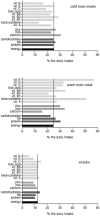A new perspective on meals as part of an Optimized Mixed Diet for children and adolescents
- PMID: 36147304
- PMCID: PMC9485454
- DOI: 10.3389/fnut.2022.981587
A new perspective on meals as part of an Optimized Mixed Diet for children and adolescents
Abstract
Objectives: To show by the example of the Optimized Mixed Diet (OMD) for children and adolescents in Germany, how the different food and nutrient profiles of the traditional daily meals complement each other to achieve daily nutrient intakes that meet the Dietary References V.
Methods: The 7-day menu plan of the OMD with the usual 5 daily meals in Germany was used. The total nutrient intake from all meals was compared with the nutrient references. Then the composition of the meals was optimized.
Results: Although the cooked meal (lunch) provides only 25% of the daily energy intake, it is relatively rich (>25% of the daily intake) in most vitamins and minerals, which distinguishes it from the other meals. The cold main meals (breakfast, dinner) are rich in calcium and vitamin B2, due to the preferential use of milk in these meals. The two snacks each provide 12.5% of the daily energy intake.
Discussion and conclusion: People eat foods but not nutrients and they eat foods as meals; this holds especially true for children and adolescents. A well-calculated menu plan can assure the nutrient adequacy of an OMD where the different food and nutrient profiles of the meals complement each other in a modular system. Guidelines for meals could facilitate flexible coordination of family meals and meals in childcare centers and schools. Different meal types set varied stimulus patterns at different levels (neurocognition, emotion, digestion), which may open up long-term health benefits.
Keywords: Optimized Mixed Diet; children; foods; meals; nutrients; nutrition.
Copyright © 2022 Kersting, Kalhoff, Sinningen and Lücke.
Conflict of interest statement
The authors declare that the research was conducted in the absence of any commercial or financial relationships that could be construed as a potential conflict of interest.
Figures
Similar articles
-
How to improve sustainability of nutrient dense diets for children and adolescents: an exemplary assessment in Germany.Eur J Nutr. 2024 Nov 16;64(1):11. doi: 10.1007/s00394-024-03530-8. Eur J Nutr. 2024. PMID: 39549094 Free PMC article.
-
Association of meal and snack patterns with micronutrient intakes among Greek children and adolescents: data from the Hellenic National Nutrition and Health Survey.J Hum Nutr Diet. 2019 Aug;32(4):455-467. doi: 10.1111/jhn.12639. Epub 2019 Apr 24. J Hum Nutr Diet. 2019. PMID: 31020750
-
Lunch on School Days in Canada: Examining Contributions to Nutrient and Food Group Intake and Differences across Eating Locations.J Acad Nutr Diet. 2020 Sep;120(9):1484-1497. doi: 10.1016/j.jand.2020.01.011. Epub 2020 Jun 2. J Acad Nutr Diet. 2020. PMID: 32507319
-
Understanding meal patterns: definitions, methodology and impact on nutrient intake and diet quality.Nutr Res Rev. 2015 Jun;28(1):1-21. doi: 10.1017/S0954422414000262. Epub 2015 Mar 19. Nutr Res Rev. 2015. PMID: 25790334 Free PMC article. Review.
-
A Historical Review of Changes in Nutrition Standards of USDA Child Meal Programs Relative to Research Findings on the Nutritional Adequacy of Program Meals and the Diet and Nutritional Health of Participants: Implications for Future Research and the Summer Food Service Program.Nutrients. 2015 Dec 4;7(12):10145-67. doi: 10.3390/nu7125523. Nutrients. 2015. PMID: 26690207 Free PMC article. Review.
Cited by
-
How to improve sustainability of nutrient dense diets for children and adolescents: an exemplary assessment in Germany.Eur J Nutr. 2024 Nov 16;64(1):11. doi: 10.1007/s00394-024-03530-8. Eur J Nutr. 2024. PMID: 39549094 Free PMC article.
-
Exploring the association between dietary Inflammatory Index and chronic pain in US adults using NHANES 1999-2004.Sci Rep. 2024 Apr 16;14(1):8726. doi: 10.1038/s41598-024-58030-w. Sci Rep. 2024. PMID: 38622145 Free PMC article.
References
-
- Das JK, Lassi ZS, Hoodbhoy Z, Salam RA. Nutrition for the next generation: older children and adolescents. Ann Nutr Metab. (2018) 72:56-64. - PubMed
-
- European Food Safety Authority Dietary Reference Values for nutrients. Summary Report. EFSA Supporting Publication. p. 98.
LinkOut - more resources
Full Text Sources


